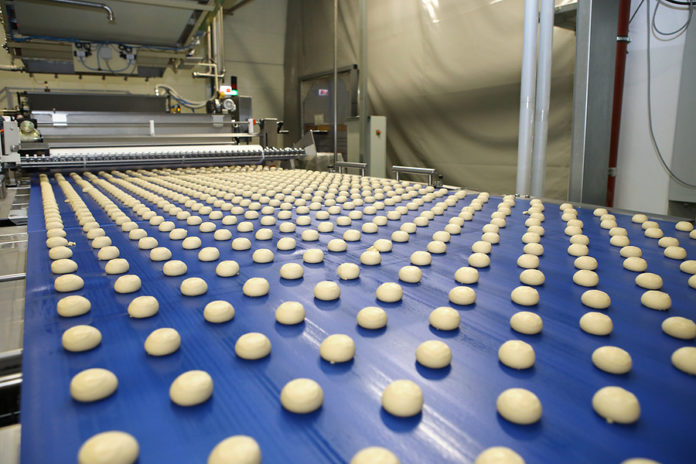
By Rick Kreczmer, RoboVent
Holiday production schedules for food manufacturing can put added strain on dust collection systems—and raise cross-contamination risks. Make sure your dust collection system is ready for the challenge.
Cross-contamination is a major concern at all times of the year, especially if you are manufacturing “free-from” food products or dealing with common allergens such as wheat flour, peanuts, or tree nuts. But when production ramps up on limited-time-offer products for the holidays, cross-contamination risks and dust collection challenges are magnified, also. Many facilities are increasing production runs or adding different products to the lineup, which may introduce different ingredients into the facility.
Dust collection is an important part of a cross-contamination prevention strategy for manufacturers. Uncontrolled food dust can propagate through the facility and settle on surfaces far from the original production line, where it creates a cross-contamination risk as well as a housekeeping problem. An effective source capture dust collection solution for each process, conveying system, or transfer point will prevent dust from escaping to other parts of the facility. This may be achieved with individual dust collection systems for each collection point or a centralized dust collector that is ducted to all collection points. A cartridge-style dust collection system provides a high degree of flexibility and efficiency for collection of food dust. When cross-contamination is a concern, the dust collector is often located outside.
When manufacturers increase production or add new processes and products to their manufacturing lines, it is important to check the dust collection system to make sure that it is still up to the task. Here are a few things manufacturers should check.
Total system capacity
A centralized dust collection system is sized based on the total volume of air you need to move (in cubic feet per minute, or CFM) and the amount of dust you need to collect (which will impact the area of filter media you need per CFM, or air-to-cloth ratio). If you are adding new production lines or processes, make sure your dust collection system has adequate airflow (CFM) to maintain appropriate air velocity for efficient capture of dust at all collection points. If not, you may need to invest in a larger dust collector or a separate dust collection system for the new lines or processes.
Maintenance and filter change schedules
What if you’re just adding more dust to your existing lines—for example, by adding a third production shift for the holiday season or a dustier product to your lineup? Your CFM may be fine, but make sure you check filters and change collection bins in your dust control system more frequently. When you are producing more dust, your filters will become loaded more quickly. Check your filters before heading into a busy production season and change them if they are nearing the end of their useful life. Be sure to closely monitor pressure drop across the filters to determine when they have become saturated. Dust trays or bins may need to be checked and emptied more frequently as well. To reduce cross-contamination concerns, use proper technique when emptying bins or changing filters to avoid creating dust clouds (especially if the dust collector is located inside the facility).
Filter selection
In addition to changing filters more frequently, you may need to consider the kinds of filter media you are using if you are introducing new ingredients or processes. Are you using specialized ingredients—for example, finely powdered sugar—during this time of the year that are not part of your normal production processes? Are you introducing different kinds of allergens into the facility, such as tree nut dust? Or, conversely, are you making specialized batches of “free-from” products that need special care to prevent cross-contamination from allergens used in your “normal” products?
Each of these cases may be a reason to rethink your filtration strategy. Finely powdered materials may require filters with a higher MERV rating than you normally use. If cross-contamination is a particular concern, make sure you are using filtration that will capture at least 99.99% of the smallest contaminant you want to collect. For fine particulate in the sub-micron range (such as dust from finely filled flours, starches, and sugars), a MERV 16 cartridge filter is recommended. A secondary HEPA after-filter may also be used to ensure final capture of very small particulate.
Filter pulsing mechanism
Before your system goes into a season of heavy use, check the filter pulsing mechanism to make sure it is working as expected. Cartridge dust collectors use a compressed air pulsing mechanism to remove excess caked dust from the filters. The mechanism periodically uses a directed blast of compressed air to pulse excess dust off the filters, where it falls into the hopper for collection in the dust tray or bin. Inspect the compressed air lines and valves and make any necessary repairs if the mechanism is not working properly. If your collector is located outside, it is especially important to watch for icing in the air supply lines or valves during the winter months. A compressed air dryer system (such as a desiccant dryer) and inline filtration will prevent moisture or particulate buildup in compressed air lines and reduce problems with the pulsing mechanism.
Are you ready?
Taking these steps will go a long way toward ensuring that your dust collection system will be able to keep up with added production without increasing cross-contamination risks. If you’re not sure if your system will be able to handle increased demands during the holiday season, it’s worth a consultation with a trusted engineering partner who can advise you on filter selection, maintenance schedules, and system capacity.
 Rick Kreczmer is an industrial air filtration industry veteran with more than 24 years of experience in sales and executive management. As President of RoboVent, he has led the company through new product innovation and market initiatives to lay the foundation for continued growth and profitability in an evolving manufacturing environment.
Rick Kreczmer is an industrial air filtration industry veteran with more than 24 years of experience in sales and executive management. As President of RoboVent, he has led the company through new product innovation and market initiatives to lay the foundation for continued growth and profitability in an evolving manufacturing environment.








